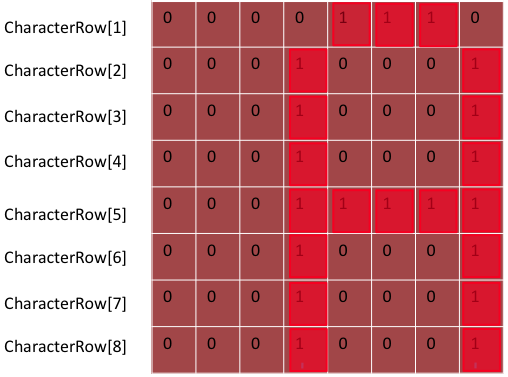Images...
My Canon SX 220 HS is a 12.1 Mega pixel camera. Looking at the manual the largest picture it will take is 4000 x 3000 pixels.
4000 x 3000 = 12,000,000
I guess the missing 0.1 million is used for image stabilisation.
So each picture you take is taking 12 million bits of information, actually it's more than that as it's also recording colour information (red, green blue), so it's probably 3 x 24 x 12 million bits of information, plus more probably!
I'm not going to attempt to explain how that works so imagine a really simple camera, a 64 bit camera or 8 x 8 pixel camera.
It only records black and white so all we are about is the on or off state of each bit / pixel.
Let's 'photograph' a letter A.
I found a nice imagine to take a 'photo' of.
As the sensor looks at the A it 'sees' this.

Luckily the image creator has already switch on the bits and marked them for me.
our 64 bits of information get recorded as
00001110
00010001
00010001
00010001
00011111
00010001
00010001
00010001
and written to the memory card, by switching 64 transistors into their on or off states as a data stream.
00001110 00010001 00010001 00010001 00011111 00010001 00010001 00010001
Later when we get home we upload our 'picture' to the computer by copying the
00001110 00010001 00010001 00010001 00011111 00010001 00010001 00010001
to the computer hard drive.
We then want to view our 'picture'
So we load our image viewing software, open our 'picture' and it reads in the data
00001110 00010001 00010001 00010001 00011111 00010001 00010001 00010001
Somewhere in the data file it will also have addition meta data (EXIF data) telling the image viewing software the size 64 bit, shape 8 x 8, and other information it needs to know.
So it sees it's an 8 x 8 image.
converts 00001110 00010001 00010001 00010001 00011111 00010001 00010001 00010001
back to
00001110
00010001
00010001
00010001
00011111
00010001
00010001
00010001
and switches on the pixels on your monitor to correspond with the bits above.
giving you this.

Marvelous stuff eh?










